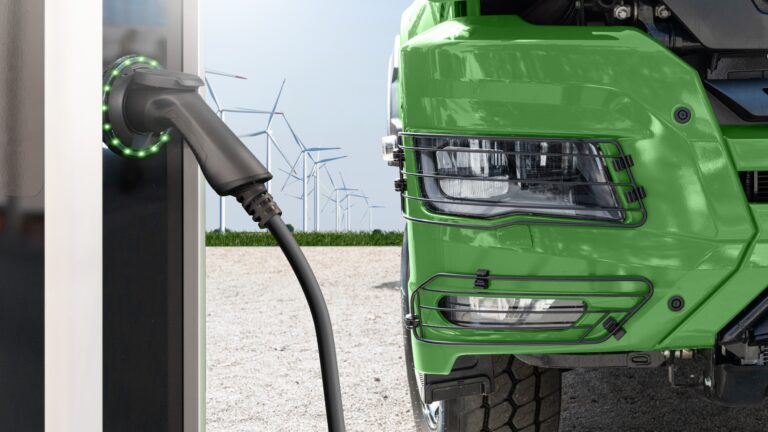
In response to the United States’ imposition of a 25% tariff on imported vehicles, the UK government has relaxed its electric vehicle (EV) regulations to shield its car industry amid mounting global competition.
We consider the implications for transport electrification, the UK’s net zero ambitions and the transport fuel landscape.
The UK’s electrification drive
Historically, the UK has been at the forefront of the EV transition in line with its legal commitment to reach net-zero carbon emissions by 2050. In 2021, transport was responsible for 26% of total UK greenhouse gas emissions – the largest emitting sector – with over half of those emissions coming from cars.
EVs are viewed by the government as central to decarbonising transport. In February 2024, the Department for Transport reiterated: “The transition to electric vehicles is a crucial step towards achieving the UK’s net zero target.”
The momentum began in 2020, when then Prime Minister Boris Johnson announced a 2030 phase-out of new petrol and diesel cars and vans. This was later delayed to 2035 by Rishi Sunak’s government in 2023, to align with EU targets.
To drive the transition, the Zero Emission Vehicle (ZEV) mandate was introduced in January 2024. It set legally binding, progressive targets: 22% of new car sales must be zero-emission in 2024, increasing to 80% by 2030 and 100% by 2035.
The policy was designed to offer manufacturers certainty while supporting economic growth and the UK’s climate goals. The government also committed over £2 billion to expand charging infrastructure and incentivise EV adoption. Yet, as of March 2025, EVs made up only 19% of new car sales – below the 28% target for the year.
The Labour Party’s 2024 general election manifesto pledged to restore the 2030 phase-out date for internal combustion engine (ICE) vehicles. However, a 2024 House of Lords report warned that high upfront costs, poor charging infrastructure, and public scepticism continue to constrain EV uptake.
UK industry and global competition
UK vehicle manufacturers have made substantial investments to repurpose production for the electric transition. According to the Society of Motor Manufacturers and Traders (SMMT), more than £20 billion was invested in 2023 alone.
However, there is global competition for investment across the EV supply chain. China overtook other nations as the world’s largest EV producer in 2023, and its exports continue to rise, placing pressure on manufacturers in Europe and the US.
Unlike other major economies, the UK has so far resisted imposing tariffs on Chinese EVs. This contrasts with measures taken elsewhere. In 2023, the US imposed 100% tariffs on EVs from China, simultaneously introducing major subsidies. The EU followed in July 2024, with tariffs of 17-38% on imported EVs from China.
UK ministers argue that avoiding tariffs helps consumers by keeping EVs affordable and avoids escalating trade tensions. However, domestic manufacturers fear an influx of cheaper Chinese models that would erode the competitiveness of British-built EVs.
A November 2023 government policy paper emphasised the UK’s focus on research and innovation over protectionism, stating it would “not be drawn into a distortive subsidy battle.”
The U.S. tariff shockwave
These global pressures were thrown into sharp relief in early April, when President Trump introduced a 25% tariff on all imported vehicles in a bid to boost American manufacturing. The impact on UK exports was immediate.
The US is the UK’s second-largest car export market, worth £7.6 billion in 2024. Lotus Cars responded by cutting 270 jobs, citing tariff-related pressures. Analysts warn up to 25,000 UK auto sector jobs could be at risk if exports to the US decline significantly.
The UK’s regulatory response
To mitigate the economic fallout, Prime Minister Keir Starmer’s government adjusted the EV mandate. Key changes include:
- Deferring fines for missing ZEV targets until 2030, and reducing penalties from £15,000 to £12,000 per vehicle
- Extending the sale of hybrid vehicles to 2035
- Exempting low-volume manufacturers such as McLaren and Aston Martin
These adjustments offer breathing space for the UK car manufacturing industry while maintaining a long-term commitment to zero-emission targets.
Impacts beyond passenger cars: The commercial vehicle challenge
The recent adjustments to UK EV policies have significant implications for commercial vehicles, particularly vans and HGVs.
Extended transition for vans
Under the revised ZEV mandate, the UK government has extended the deadline for phasing out new internal combustion engine (ICE) vans. Previously set for 2030, the new deadline allows the sale of new petrol and diesel vans until 2035. This extension also applies to full hybrid and plug-in hybrid vans, providing manufacturers and fleet operators with additional time to adapt to the transition.
Even without this extension, the uptake of electric vans remains sluggish. As of early 2025, zero-emission vans accounted for only 5.7% of new van sales, falling short of the 10% target. Major manufacturers, including Ford and Stellantis, have expressed concerns that penalties for missing these targets could hinder further EV development and have already led to job cuts.
Challenges in HGV electrification
The government has committed to phasing out diesel HGVs: those under 26 tonnes by 2035 and all HGVs by 2040. Yet operators face high vehicle costs, limited charging infrastructure, and scant financial support.
Regulatory tweaks
The government has proposed:
- Allowing Category B licence holders to drive EVs up to 4.25 tonnes
- Reclassifying 4.25-tonne electric vans, currently treated as HGVs due to their weight, to align with diesel van rules, easing driver and regulatory burdens
Logistics UK welcomed the clarity, but its Deputy Policy Director, Michelle Gardner, noted: “The sector is fully committed to decarbonisation, but zero tailpipe emission vehicles must make commercial and operational sense. Our members still face cost and infrastructure barriers that need urgent government attention.”
Implications for net zero
While relaxing regulations provides short-term relief, it risks undermining the UK’s long-term climate goals. Delayed targets could slow emissions reductions from the UK’s highest-emitting sector potentially jeopardising the UK’s commitment to net zero 2050.
EV sales could also be impacted by the introduction of Vehicle Excise Duty (VED) on electric cars from April 2025. However, Transport Secretary Heidi Alexander downplayed concerns, saying the adjustments would have a “negligible” impact on emissions.
A new role for HVO?
In this regulatory vacuum, interest in Hydrotreated Vegetable Oil (HVO) is rising. The relaxation of EV targets and the extended transition timelines for commercial vehicles – particularly vans and HGVs – is increasing interest in HVO as a near-term solution for fleet decarbonisation.
Why HVO?
- Drop-in compatibility: Works with existing diesel engines
- GHG savings: Up to 90% lifecycle CO2 reduction
- No infrastructure upgrade needed: a practical interim pathway
What’s holding it back?
- Higher cost
- Supply concerns
- Policy: Lack of targeted incentives
Many view it as a bridge fuel – valuable now, but not a long-term solution.
As fleet operators seek to decarbonise while navigating regulatory uncertainty and infrastructure delays, HVO demand is likely to increase. But whether this demand can be met – and sustained – will depend on market forces, fuel pricing, and the broader transport decarbonisation strategy.
Navigating the road ahead
The UK’s pivot on EV legislation underscores the delicate balancing act between economic resilience and environmental responsibility. Trade policy, industrial competitiveness, and climate ambition are increasingly entangled – and transport policy is one area where this complex struggle is visibly playing out.
Sustained investment in EV production, charging infrastructure, and consumer incentives will be crucial if the UK is to get back on track.
Wider lessons for the transition
The challenge of balancing industrial competitiveness with environmental ambition – and ensuring consumers are not burdened with unsustainable costs – is not unique to the automotive sector. It reflects a broader trilemma facing governments worldwide as they navigate the energy transition.
From electricity pricing to heat decarbonisation to heavy industry reform, governments face mounting pressure to align economic security with environmental integrity.
These trade-offs are one of the defining tensions of the net zero journey and the UK’s recalibration on EVs shows how these evolving and competing pressures are shaping real-time policy decisions.
Transport fuel shift underway, but diesel still dominates – for now
The latest Motorparc 2024 report from the Society of Motor Manufacturers and Traders (SMMT), released on April 12, paints a picture of an evolving transport landscape – one that is making progress toward decarbonisation, but still heavily reliant on fossil fuels.
Electric vehicles (EVs) hit a major milestone in 2024, with more than 1.3 million electric cars now on UK roads, a 38.9% increase year-on-year. Yet, despite this growth, 96.3% of the UK car parc still fills up with petrol or diesel. The total number of vehicles on British roads also reached a new high of 41.96 million, up 1.4%, with the vast majority continuing to depend on internal combustion engines.
Battery electric vehicles (BEVs) now account for 3.7% of all cars in use, while diesel volumes fell by 4.4% to 11.6 million units, representing 32.1% of the car parc – the fuel type’s fifth consecutive year of decline. This trend signals a steady erosion of the dominance of traditional diesel, particularly in company fleets where CO₂ emissions fell by 5.6%, driven by fiscal incentives and an expanding range of electrified models.
Commercial sector: diesel holding, but changes are emerging
The commercial vehicle sector remains more firmly rooted in diesel, but the transition is beginning to impact. Vans, which underpin much of the UK’s logistics activity, hit a record 5.1 million units in 2024, with battery electric vans growing 31.6% to 80,476 units – now 1.6% of the van parc. While still a small proportion, the growth trend is clear.
Electric buses saw an even sharper rise, increasing by 81.8% year-on-year to make up 4.9% of the total bus fleet – despite overall public transport vehicle numbers falling to their lowest recorded level. Electric trucks are also beginning to appear in the fleet mix, though from a very small base and still account for less than 0.1% of heavy goods vehicles.
Implications for fleet operators and fuel suppliers
These trends underscore the rising operational presence of EVs, particularly in van fleets and public service vehicles. However, diesel remains critical – particularly for long-haul, high-utilisation, and rural applications where electrification is not yet practical.
This transition phase presents a significant opportunity for suppliers of low-carbon liquid fuels to bridge the gap, supporting fleet operators as they move toward net zero without compromising on range or reliability in the short to medium term.
Image credit: Dreamstime

